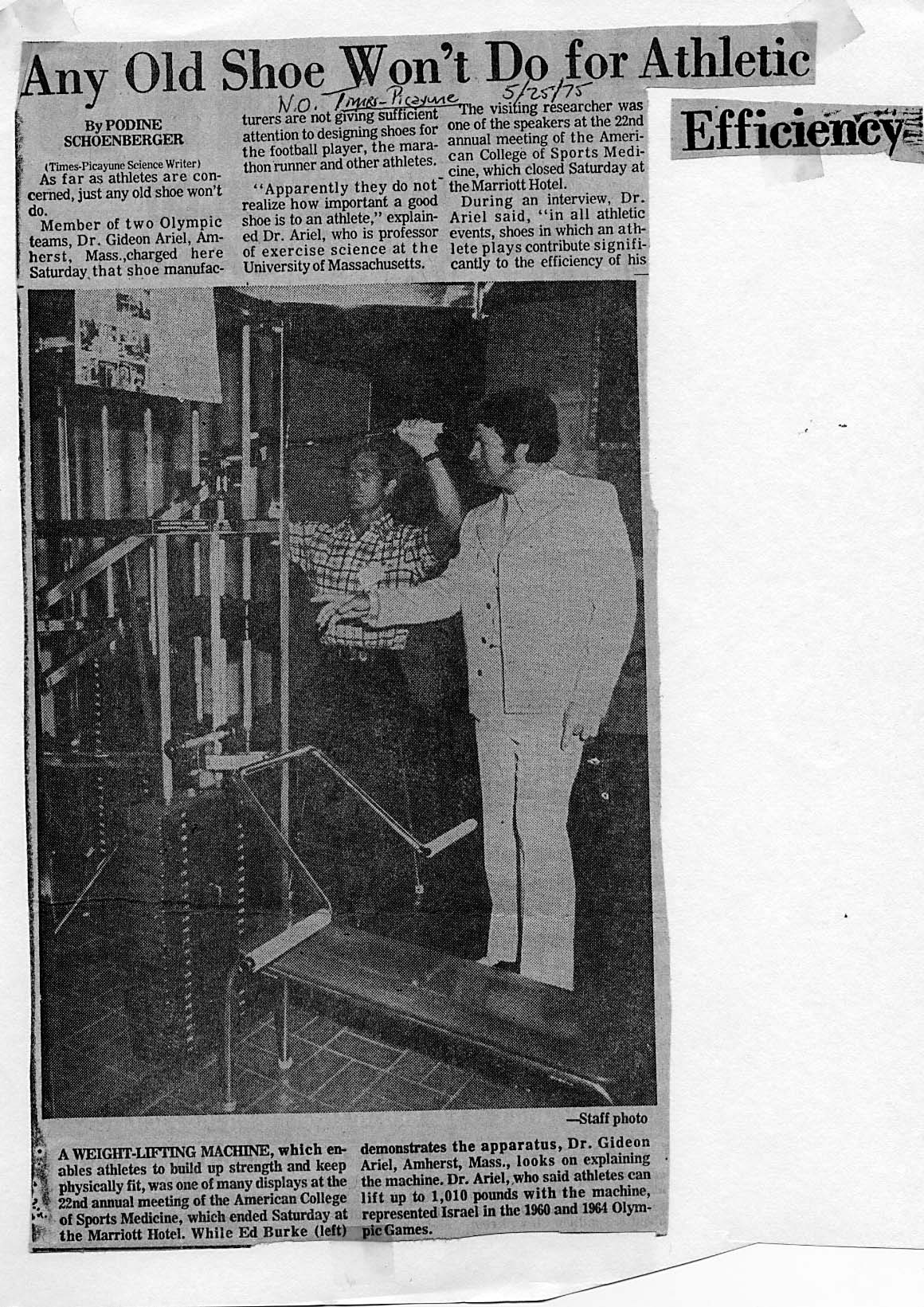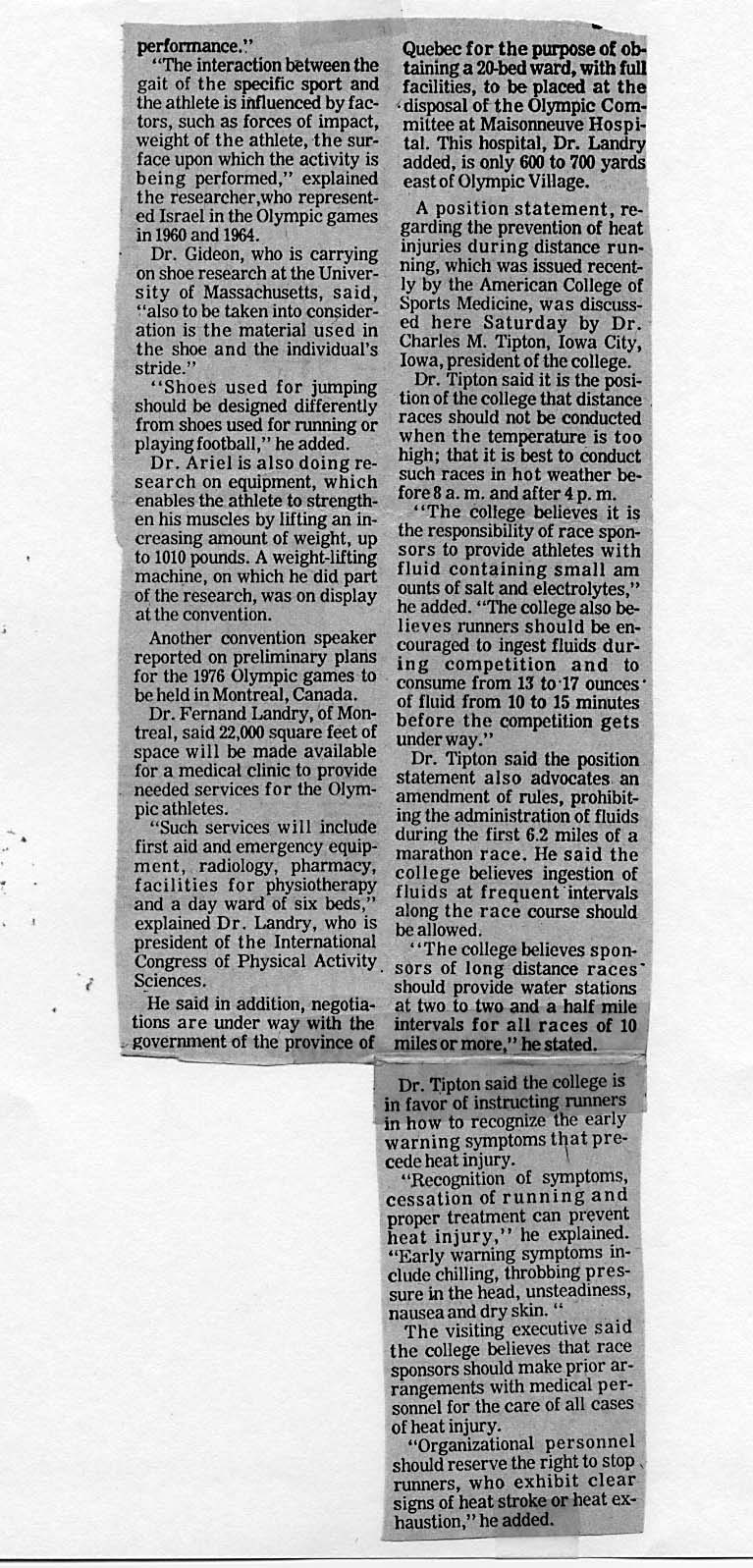Any Old Shoe Won't Do for Athletic Efficiency
As far as athletes are concerned, just any old shoe won't do
By Podine Schoenberger in Times Picayune on Sunday, May 25, 1975
Article Synopsis
In an interview, Dr. Gideon Ariel, a professor of exercise science at the University of Massachusetts and a member of two Olympic teams, emphasized the importance of shoes in athletic performance. He explained that the interaction between the athlete's gait and the specific sport is influenced by factors such as impact forces, the athlete's weight, and the surface of the activity. He also noted that the material used in the shoe and the individual's stride should be considered.
Dr. Ariel is conducting research on shoes and has developed a weight-lifting machine that allows athletes to strengthen their muscles by lifting up to 1010 pounds.
The article also reports on preliminary plans for the 1976 Olympic games in Montreal, Canada. Dr. Fernand Landry, president of the International Congress of Physical Activity Sciences, shared that a 22,000 square feet medical clinic will be established to provide necessary services for the Olympic athletes.
The American College of Sports Medicine issued a position statement on the prevention of heat injuries during distance running. The statement recommends conducting races in cooler temperatures, encouraging athletes to ingest fluids during competition, and amending rules to allow fluid intake during the first 6.2 miles of a marathon. The college also advocates for race sponsors to provide water stations at regular intervals and to make arrangements with medical personnel for the care of heat injuries.
Tip: use the left and right arrow keys
realize how important a good During an interview, Dr. shoe is to an athlete," explain- Ariel said, "in all athletic ed Dr. Ariel, who is professor events, shoes in which an athof exercise science at the lete plays contribute signifiUniversity of Massachusetts. cantly to the efficiency of his
By PODINESCHOENBERGER
(Times-Picayune Science Writer)
As far as athletes are concerned, just any old shoe won't do.
Member of two Olympic teams, Dr. Gideon Ariel, Amherst, Mass.,charged here Saturday, that shoe manufac
:3 A WEIGIIT-LIFTING MACHINE, which enables athletes to build up strength and keepphysically fit, was one of many displays at the22nd annual meeting of the American Collegeof Sports Medicine, which ended Saturday at' the Marriott Hotel. While Ed Burke (left)
-Staff photo
demonstrates the apparatus, Dr. Gideon Ariel, Amherst, Mass., looks on explaining the machine. Dr. Ariel, who said athletes can lift up to 1,010 pounds with the machine, represented Israel in the 1960 and 1964 Olym
pic Games. 4
performance." Quebec for the purpose of ob
"The interaction between the taining a 20-bed ward, with full gait of the specific sport and facilities, to be placed at the the athlete is influenced by fac- disposal of the Olympic Comtors, such as forces of impact, mittee at Maisonneuve Hospiweight of the athlete, the sur- tal. This hospital, Dr. Landry face upon which the activity is added, is only 600 to 700 yards being performed," explained east of Olympic Village. the researcher,who represent- A position statement, reed Israel in the Olympic games
in 1960 and 1964. garding the prevention of heat
run
Dr. Gideon, who is carrying injuries during distance runon shoe research who the carrying Univer- ning, which was issued recenton of Massachusetts, said, Sports ly by the Americans College of
to be taken into consider- d here Saturday by wa biscDro ation is the material used in Charles ip on, I City, the shoe and the individual's owapresident Tit a col Cit, stride." I, of the college.
"Shoes used for jumping Dr. Tipton said it is the posisho Sh be designed differently tion of the college that distance from shoes used for running or races should not be conducted playing football," he added. when the temperature in too
Dr. Ariel is also doing re- high; that it is best to conduct
be
search e also such races in hot weather beenables the athlete to strength- fore 8 a. m. and after 4 p. m.
en his muscles by lifting an in- "The college believes it -
creasing amount of weight, up she s to pr responsibility athletes with
to 1010 pounds. A weight-lifting ors containing ahletes small with machine, on which he did part fluid cotaiing smay a of the research, was on display he added. salt and leolso be" at the conventin. he "The college al beat runners should be en
Another convention speaker couraged to ingest fluids durreported on preliminary plans ing competition and to for the 1976 Olympic games to consume from 13 to-17 ounces be held in Montreal, Canada. of fluid from 10 to 15 minutes
Dr. Fernand Landry, of Mon- before the competition gets treal, said 22,000 square feet of underway." space will be made available Dr. Tipton said the position for a medical clinic to provide statement also advocates an needed services for the Olym- amendment of rules, prohibit
pie athletes. ing the administration of fluids
"Such services will include during the first 6.2 miles of a first aid and emergency equip- marathon race. He said the ment, radiology, pharmacy, college believes ingestion of facilities for physiotherapy fluids at frequent intervals and a day ward of six beds," along the race course should explained Dr. Landry, who is be allowed. president of the International ''The college believes sponCongress of Physical Activity. sors of long distance races"
Sciences. should provide water stations
He said in addition, negotia- at two to two and a half mile tions are under way with the intervals for all races of 10 government of the province of miles or more," he stated.
Dr. Tipton said the college is in favor of instructing runners in how to recognize the early warning symptoms that precede heat injury.
"Recognition of symptoms, cessation of running and proper treatment can prevent heat injury," he explained. "Early warning symptoms include chilling, throbbing pressure in the head, unsteadiness, nausea and dry skin. "
The visiting executive said the college believes that race sponsors should make prior arrangements with medical personnel for the care of all cases of heat injury.
"Organizational personnel should reserve the right to stop . runners, who exhibit clear signs of heat stroke or heat exhaustion," he added.


